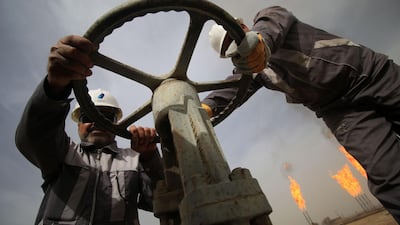Iraq could save about US$5.2 billion over the next four years by reducing gas flared from its fields in addition to other power generation efficiency efforts, as the world's third-biggest oil exporter looks to end flaring by 2021, Siemens said.
Siemens presented a plan to Iraqi Prime Minister Haider Al Abadi to help with reconstruction efforts including a blueprint to "ensure uninterrupted power supply of up to 16 gigawatts by 2025 to major Iraqi cities and beyond". The proposal comes amid Baghdad's increasing efforts to tap foreign aid and move ahead with reconstruction following the defeat of ISIL.
Iraq has estimated it needs around $100bn to rebuild essential infrastructure, including its struggling power grid, which has led to widespread protests against the government, particularly during the summer, when the temperature index can reach up to 70 degrees Celsius in parts of the country. The government is presently lobbying for about $88bn in funding at a World Bank-led donor conference in Kuwait, where the host nation has pledged $2bn to help rebuild its northern neighbour.
Siemens's push to help Iraq snuff out flared gas by 2021 is the latest effort by international power companies that also include GE, who have lined up to build power stations that can run on gas currently being burnt from southern oil fields. GE has added around 400MW to Iraq's power grid from the first wave of flared gas recovery in the country.
_____________
Read more:
Iraq to reach 'zero gas flaring' by 2021, says oil minister
Exclusive: Siemens expects uptick in growth of regional business on back on Iraq energy needs
_____________
Last month, Iraq's Oil Minister, Jabbar Al Luaibi, said in Abu Dhabi that the country aims to reach "zero gas flaring" by 2021.
“By the middle of this year, we’re heading definitely to conclude three giant contracts with international gas companies to utilise the gas in all southern areas [to the tune of] 950 million scf [standard cubic feet] covering Basra, Nassriya and Missan," he said last month. The implementation of that strategy by end of 2021 "will see Iraq reach zero flaring definitely”.
The World Bank estimates around 16 billion cubic metres of gas from Iraqi fields was flared in 2015, costing the economy billions in lost revenue.
In an interview with The National last month, Siemens Middle East chief executive Dietmar Siersdorfer said he expected new regional growth to come from rehabilitation efforts in Iraq and Syria.
As part of its roadmap for Iraqi re-construction, Siemens is set to deploy plug-and-play power solutions that could be installed and operational in three months to medium and long-term projects that would take 10 and 24 months, as well as longer-term projects.


